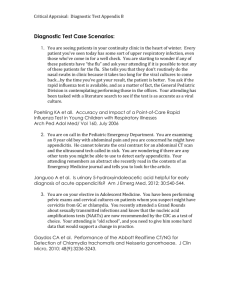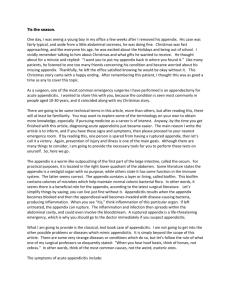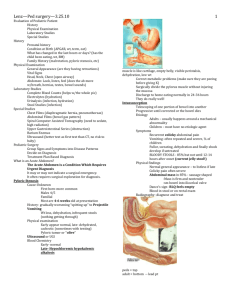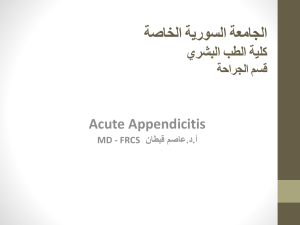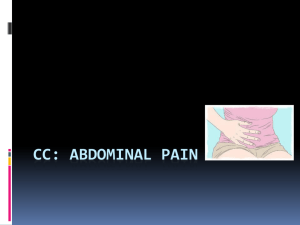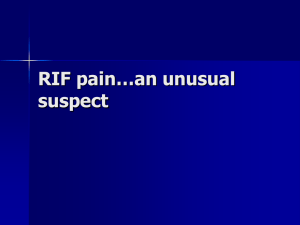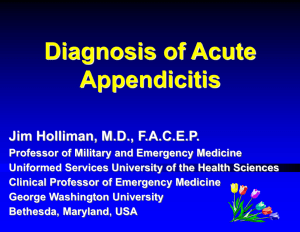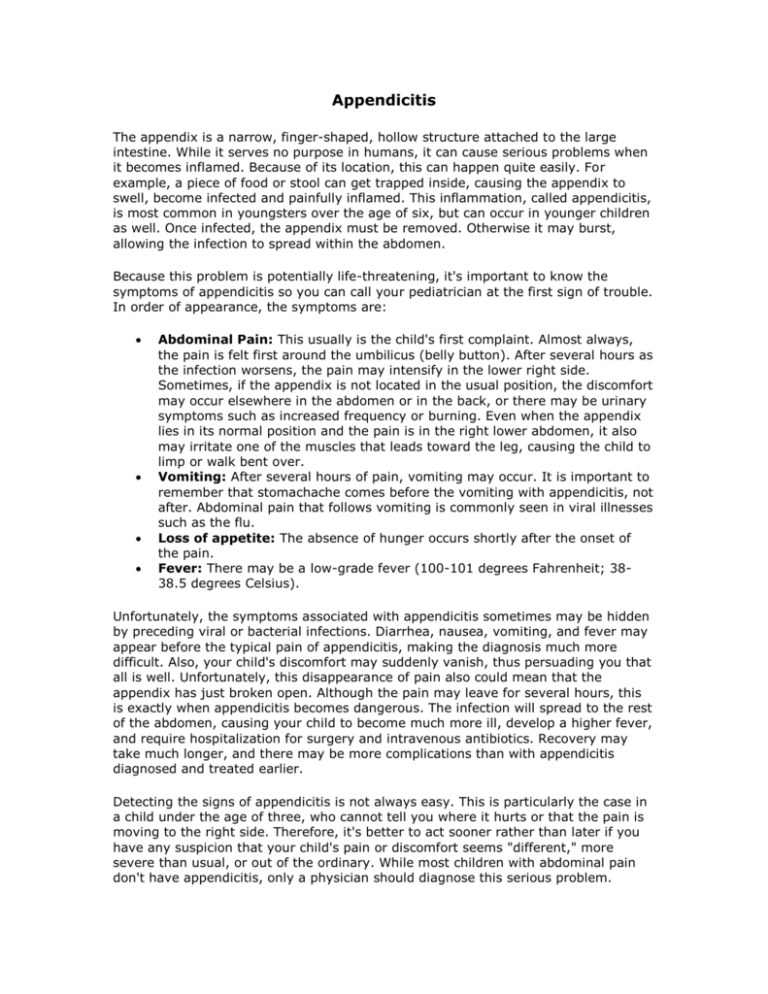
Appendicitis
The appendix is a narrow, finger-shaped, hollow structure attached to the large
intestine. While it serves no purpose in humans, it can cause serious problems when
it becomes inflamed. Because of its location, this can happen quite easily. For
example, a piece of food or stool can get trapped inside, causing the appendix to
swell, become infected and painfully inflamed. This inflammation, called appendicitis,
is most common in youngsters over the age of six, but can occur in younger children
as well. Once infected, the appendix must be removed. Otherwise it may burst,
allowing the infection to spread within the abdomen.
Because this problem is potentially life-threatening, it's important to know the
symptoms of appendicitis so you can call your pediatrician at the first sign of trouble.
In order of appearance, the symptoms are:
Abdominal Pain: This usually is the child's first complaint. Almost always,
the pain is felt first around the umbilicus (belly button). After several hours as
the infection worsens, the pain may intensify in the lower right side.
Sometimes, if the appendix is not located in the usual position, the discomfort
may occur elsewhere in the abdomen or in the back, or there may be urinary
symptoms such as increased frequency or burning. Even when the appendix
lies in its normal position and the pain is in the right lower abdomen, it also
may irritate one of the muscles that leads toward the leg, causing the child to
limp or walk bent over.
Vomiting: After several hours of pain, vomiting may occur. It is important to
remember that stomachache comes before the vomiting with appendicitis, not
after. Abdominal pain that follows vomiting is commonly seen in viral illnesses
such as the flu.
Loss of appetite: The absence of hunger occurs shortly after the onset of
the pain.
Fever: There may be a low-grade fever (100-101 degrees Fahrenheit; 3838.5 degrees Celsius).
Unfortunately, the symptoms associated with appendicitis sometimes may be hidden
by preceding viral or bacterial infections. Diarrhea, nausea, vomiting, and fever may
appear before the typical pain of appendicitis, making the diagnosis much more
difficult. Also, your child's discomfort may suddenly vanish, thus persuading you that
all is well. Unfortunately, this disappearance of pain also could mean that the
appendix has just broken open. Although the pain may leave for several hours, this
is exactly when appendicitis becomes dangerous. The infection will spread to the rest
of the abdomen, causing your child to become much more ill, develop a higher fever,
and require hospitalization for surgery and intravenous antibiotics. Recovery may
take much longer, and there may be more complications than with appendicitis
diagnosed and treated earlier.
Detecting the signs of appendicitis is not always easy. This is particularly the case in
a child under the age of three, who cannot tell you where it hurts or that the pain is
moving to the right side. Therefore, it's better to act sooner rather than later if you
have any suspicion that your child's pain or discomfort seems "different," more
severe than usual, or out of the ordinary. While most children with abdominal pain
don't have appendicitis, only a physician should diagnose this serious problem.
If the abdominal pain persists for more than an hour or two, and if your child also
has nausea, vomiting, loss of appetite, and fever, notify your pediatrician
immediately. If the doctor is not certain the problem is appendicitis, she may decide
to observe your child closely for several hours, either in or out of the hospital. During
this time, she will have performed additional laboratory or X-ray examinations to see
if more conclusive signs develop. If there is a strong probability that appendicitis is
present, surgery usually will be done as soon as possible.
In almost all cases, the treatment of appendicitis is surgical removal of the appendix.
In rare instances, the tissue covering the intestines may enclose the appendix, thus
containing the infection. This makes it more difficult to remove the appendix without
spreading the infection, so antibiotics may be used, either alone or combined with
drainage of the infection by a small tube. Because inflammation can recur even after
the initial infection is gone, the appendix usually is removed later on.
© Copyright 2000 American Academy of Pediatrics
Excerpted from "Caring for Your Baby and Young Child: Birth to Age 5" Bantam 1998
© COPYRIGHT AMERICAN ACADEMY OF PEDIATRICS, ALL RIGHTS RESERVED.
American Academy of Pediatrics, 141 Northwest Point Blvd., Elk Grove Village, IL, 60007, 847-434-4000


